FORM 3: FORCES THAT AFFECT THE EARTH
The Forces Which Cause Earth Movement and their Origin
Explain the forces which cause earth movement and their origin
INTERNAL FORCES:These
are forces which operate within the earth‘s crust. Internal forces
include vulcanicity and earth movements, that is, horizontal (lateral)
and vertical movements. These forces may result into formation of
several landform features.
EXTERNAL FORCES:
These are natural forces that operate on the earth’s surface. The
forces mainly act on the earth’s crust or close the surface of the
earth. Often the features produced by these forces are seen on the
surface of the earth. They include mountains, volcanoes, moraines and
valleys, just to mention a few
The Vertical/Radical Movement
Describe the vertical/radical movement
The
earth is in constant motion and this movement results to a number of
features such as mountains, plateaus and plains. Such features are due
to both lateral and vertical movements. These movements exert great
force of tension and compression which later results to very impressive
features. Earth movements are either vertical or lateral.
The Resulting Features from the Vertical Movement
Identify the resulting features from the vertical movement
Vertical earth movements:
These are up and down movements which cause the crustal rocks to fault.
These movements result to a number of landforms such as plateaus, block
mountains, rift valleys, basins, etc.
Lateral or Horizontal Movement
Different Features Produced by Horizontal Forces
Identify different features produced by horizontal forces
Features associated with earth movements
Rift Valley
Rift
valley is a trough or hollow which may result from both vertical and
lateral movements of the earth’s crust. It is formed when two faults
develop parallel to each other. It can develop either by tensional
forces or compressional forces.
Formation of rift valley by tensional forces
This
is formed when tensional forces move away from each other. These forces
of tension produce faults and the block between two parallel faults
subsides to form a rift valley.
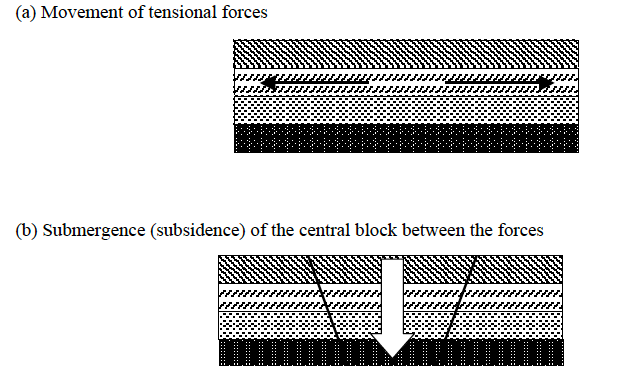

Formation of the Rift Valley by compressional forces
This
is formed when horizontal forces act towards each other. These forces
of compression produce faults on the outside of the two parallel faults
and the pieces of land on either side are lifted up above the general
level of the ground to form a rift valley.
Diagrammatically, formation of the Rift Valley occurs like this:
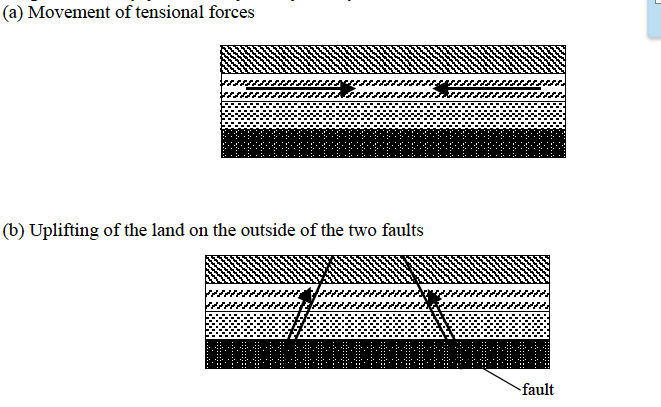

Examples of rift valleys include:
- East African rift valley – Africa;
- Jordan rift valley – Asia;
- Rhineland rift valley – Europe.
Block mountain (horst)
A
block mountain refers to a table-like mountain formed due to the
influence of faulting that leads to rising of crustal rocks. It is
nearly a flat surface. A block mountain can be formed by either
tensional or compressional forces. This is when the earth’s movements
cause parallel faults which results into uplifting of some parts.
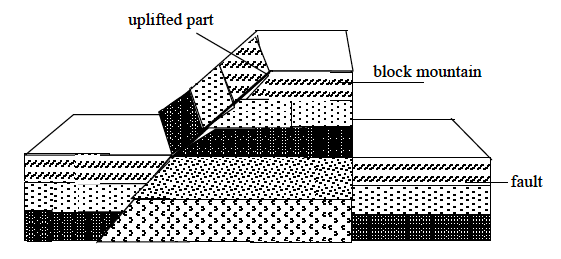
Examples of block mountains are:
- Usambara and Uluguru, in Tanzania;
- Ruwenzori, in Uganda;
- Vosges and Black Forest, in Europe; and
- Mount Sinai in Asia.
Plateau
A
plateau is a large, extensive uplifted part of the earth’s crust which
is almost flat at the top. The top of the plateau is mostly a plain.
Plateaus were formed during Mesozoic and Jurassic eras. It was due to
uplifting of the earth’s crust. Such landforms include those of East
African and Brazilian plateaus. High plateaus especially in tropical
latitudes are used for agriculture and settlement.
Basin
A basin is a large, extensive depression on the earth’s surface. Most basins are formed due to vertical movement of the earth.
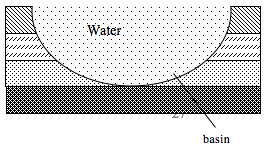
Examples of basins include:
- an inland drainage e.g. Congo basin;
- Chad basin; and
- Amazon basin.
Vulcanicity
Causes of Volcanicity and Resulting Features
Explain causes of volcanicity and resulting features
There are two types of vulcanicity namely, intrusive vulcanicity and extrusive vulcanicity
Intrusive (internal) vulcanicity
This
occurs when the magma cools, solidifies and forms features within the
earth‘s crust before it reaches the earth‘s surface. The features
(landforms) formed by this process are sometimes termed as intrusive
(internal) features.
The following are the landforms formed through intrusive vulcanicity:
Dyke
This
is a wall-like feature cutting across the bedding planes. It is formed
when magma cools and solidifies vertically across bedding planes. The
dyke is termed as a small-scale intrusive feature. Sometimes the dyke
may form a waterfall when exposed to the earth‘s surface due to
denudation processes.

Examples of dykes are Mwadui dyke in Tanzania, Gabbro dyke in Lesotho, and Tyolo dyke in Malawi.
Sill
This
is an intrusive feature which lies horizontally along the bedding
planes. It is formed when magma cools and solidifies horizontally along a
bedding plane. Like the dyke, the sill is termed as a small-scale
intrusive feature.
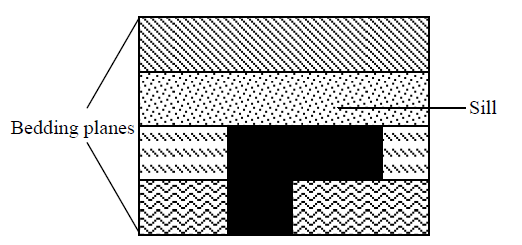
An example of a sill is Fouta Djallon ranges in Guinea.
Laccolith
This
is an intrusive feature which looks like a dome. It is formed when the
magma cools and solidifies in anticline bedding plane. Sometimes it can
be exposed to the earth‘s surface following denudation processes.
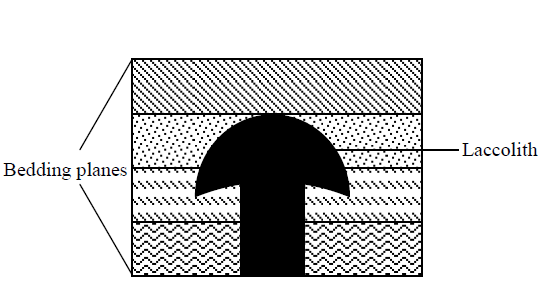
Lapolith
This
is an intrusive feature which looks like a saucer in shape. It is
formed when magma (molten rocks) cools and solidifies in a syncline
bedding plane.
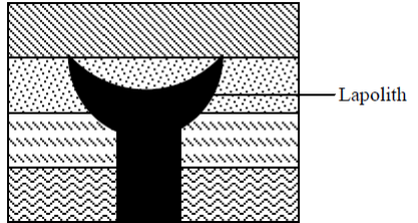
Examples of lapoliths are found in South Africa especially in Trans Vaal province.
Batholith
This
is a very large mass of magma which cools and solidifies in the earth‘s
crust. Sometimes if forms the root or core of a mountain. Batholiths
are made of granite and they form surface features only after they have
been exposed to the earth‘s surface by denudation. Sometimes batholiths
resist erosion and form uplands.
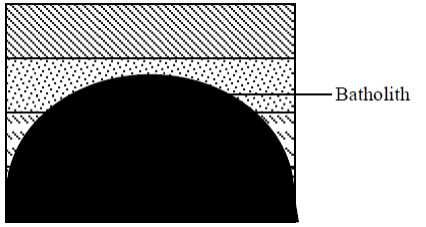
Examples of batholiths are found in Zimbabwe, Tanzania, Zambia and Gabon (The Chaillu Massif).
Phacolith
This
is a lens-shaped mass of igneous rock. It is formed when magma cools
and solidifies at anticline and syncline in folded rocks.
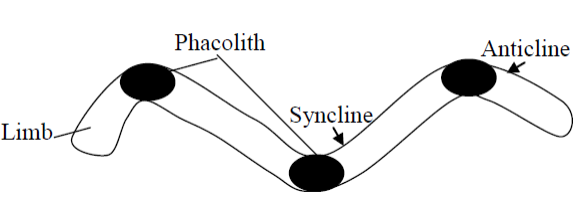
An example of a phacolith is The Gordon Hill in UK.
Features Resulting from the Processes of Volcanicity
Classify features resulting from the processes of volcanicity
Eruption
of magma, either intrusive or extrusive, results in the formation of
features. Intrusive features are the result of cooling and
solidification of magma inside the crust. The features formed includes
dyke, sill, laccolith and batholith. Extrusive features include the
formation of volcanoes, domes, craters and calderas.
Distribution of Major Volcanic Zones in the World
Locate the distribution of major volcanic zones in the world
Extrusive (external) vulcanicity
This
is the type of vulcanicity that occurs when molten rocks reach the
surface of the earth. When magma emerges at the surface it is called
lava. This forms features called extrusive features of vulcanicity. The
following are landforms due to extrusive vulcanicity:
Acidic lava cone
This
is a cone made of viscous lava. Normally lava cones have high heights
and break into small fragments. The acidic lava always cools faster than
basic lava because is it viscous.
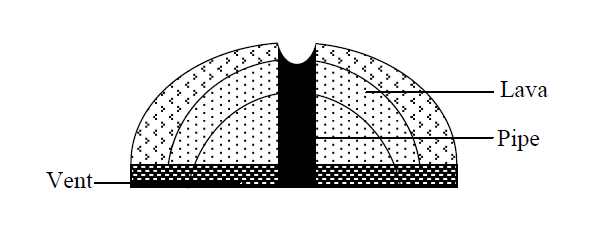
Examples
of acidic lava cone include:Mount Kilimanjaro found in Tanzania (East
Africa).Mount Kenya found in Kenya (East Africa).Mount Fuji found in
Japan.Mount Vesuvius found in Italy.
Basic lava cone
This is a cone made up of basic (fluid) lava. Normally cones have gentle slopes and spread over a long distance.
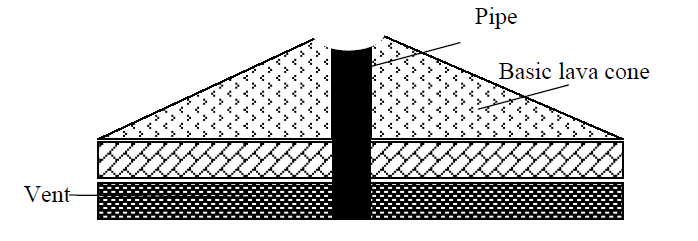
Examples of basic lava cones are Mauna Loa cone of Hawaii and basaltic dome of Nyamlangir, near to Lake Kivu in DRC.
Ash and cinder cone
This
is a cone made up of ashes and stones that erupted from beneath
(interior) the earth to form a concave cone. The slopes of a cone are
usually concave due to the spreading tendency. Lava is blown to great
heights when it is violently ejected, and it breaks into small fragments
which fall back to the earth and build up a cone.
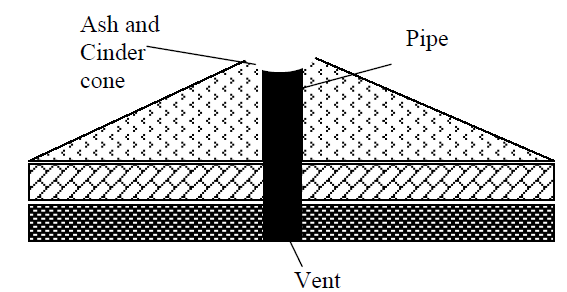
Several
ash and cinder cones occur just south of Turkana, in Kenya. These are
Likaiyu and Teleki (both cinder cones), and Nabuyatom (ash cone).Other
examples of cinder cones outside Africa are Volcano de Fuego, in
Guatemala and Paricutin, in Mexico.
Crater
The
crater is a small depression on the volcanic cone or mountain. It is
sometimes filled with water to form a crater lake. It is formed when
volcanic eruption ceases and leaves a hole on the basic lava cone. An
example of a crater is Ngorongoro crater in Tanzania.
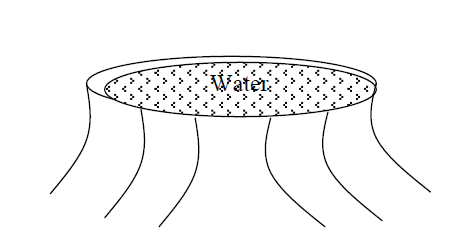
Volcanic plug
This
is a big rock which plugs or blocks the top of the pipe. It is formed
when lava solidifies quickly to block the pipe. Examples of volcanic
plugs are Mount Palace in France and Hoggar mountains in Algeria.
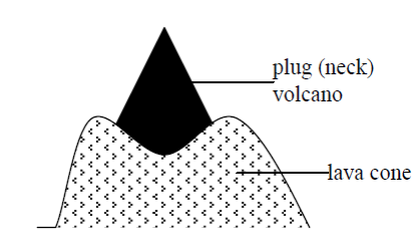
Composite cone
This
type of a cone is formed of alternate layers of ash and lava. The
volcano begins each eruption with great violence forming a layer of ash.
As the eruption proceeds, the violence ceases and lava pours out
forming a layer on top of the ash.

Examples
of composite cones are Mount Kilimanjaro, in Tanzania and Mount
Cameroon. Other examples outside Africa are Vesuvius, Etna and
Stromboli, all of which are in Italy.
Caldera
This
is a large depression on top of a volcanic cone. It is formed when a
composite volcano explodes so violently that its top is blown off and
disintegrates into a mass of rocks and ashes, leaving the crater greatly
enlarged. This huge crater-like depression is what we call a caldera.
Sometimes a caldera can be filed with water to form a caldera lake. Lake
Shala, in Ethiopia, is the largest caldera lake in the world.
Examples of calderas are:
- Ebogar caldera, in Cameroon
- Longonot caldera, in Kenya, which lies in the Eastern Rift Valley, about 140 km south of Mount Kenya.
The stages in the formation of a caldera
First stage:Magma cannot escape to the surface and collects under the lower crust.
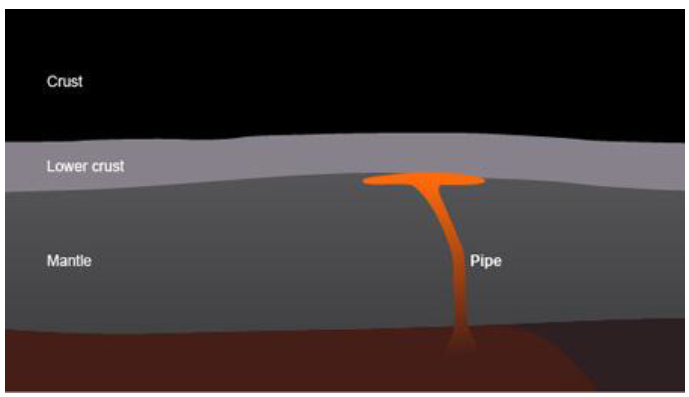
Second stage:An 'uplifted bulge' begins to form under the lower crust as the magma chamber enlarges.
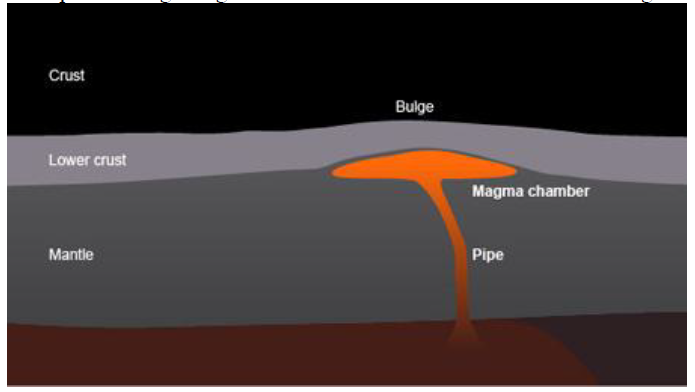
Third stage:Cracks appear on the surface. Gas and ash erupt from the magma chamber through these cracks.
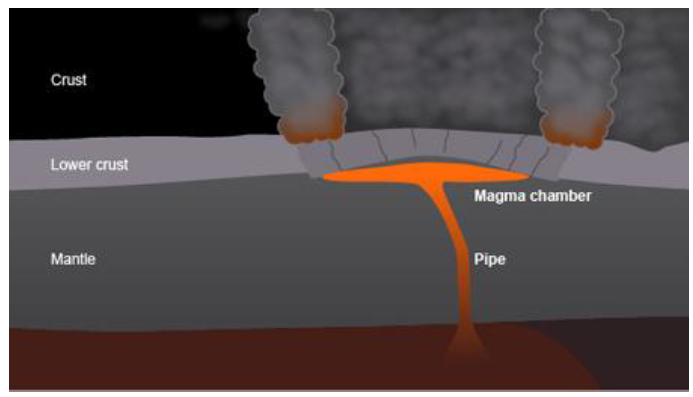
Fourth stage:The magma chamber collapses and a depression is formed. This is called a caldera.
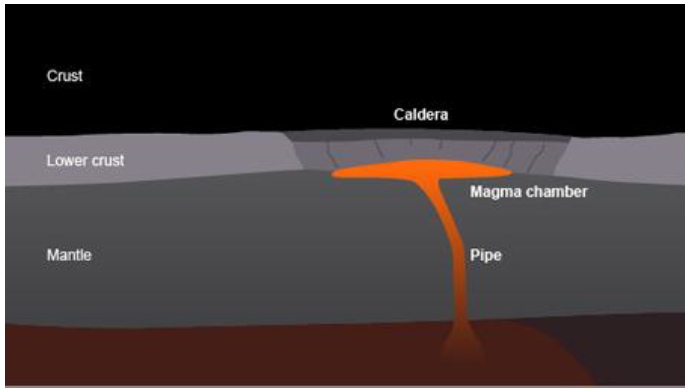
Geysers and hot springs
- A geyser refers to the forceful emission of hot water and steam from the ground to a high level in the air. The ejected water contains fine materials such as volcano mud, which later form fertile soils. Geysers are found in Iceland, North Island and New Zealand.
- A hot spring refers to natural outflow of superheated water from the ground. It contains mineral substances in solution. Hot springs are found in Iceland, in Europe; and Kenya and Ethiopia, in Africa.

Hot springs are also found in Manyara National Park, Songwe, in Mbeya and in Nigeria.
Lava plateau
This
is an extensive and flat landform which is formed when molten magma
flows onto the earth‘s crust through fissure. Examples are found in
Ethiopia highland, Bui plateau in Nigeria and Daccan plateau in India.
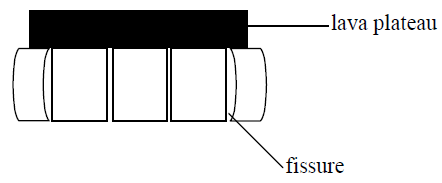
Distribution of major volcanic zones in the world
The
distribution of volcanoes is as shown in the world map below. Most
volcanoes are found in continents bordering the Pacific Ocean, an area
referred to as Ring of Fire. The Ring of Fire is the name for the area
around the Pacific Ocean where so many of the world‘s volcanoes are
found. Besides volcanoes, there are also more earthquakes in Ring of
Fire than the rest of the world. Many islands, like the Hawaiian
Islands, are formed from volcanoes.
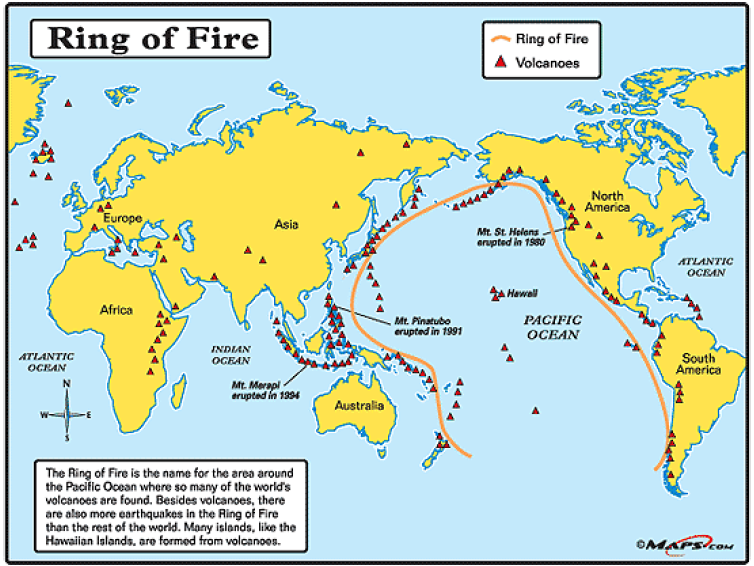
The Economic Importance of Volcanoes
Assess the economic importance of volcanoes
Vulcanicity results to features that are of economic value to man as outlined below:
- The larva poured onto the earth‘s surface following vulcanicity forms a fertile soil upon weathering. This soil supports agriculture as well as forestry. Examples of fertile volcanic soils that resulted from volcanic activities are the rich acidic soils on the slopes of mounts Kilimanjaro, Kenya and Elgon, which supports the growth of coffee, banana, tea and other crops.
- When the magma solidifies, it forms hard rocks that can be quarried and used to construct roads, bridges, houses and other infrastructures.
- Spectacular features formed upon vulcanicity such as mountains, calderas, caldera lakes, cones, geysers and hot springs are interesting to look at. As such, they attract tourist and hence earn foreign currency to the country.
- Vulcanicity brings minerals from deep the earth‘s crust to close or onto the earth‘s surface. Various minerals and gemstones are mainly found in the volcanic regions. Diamond in Mwadui is mined from the volcanic plugs and dykes. Gold and silver are associated with the Nyanza batholith in Kenya.
- Geysers can be harnessed to generate geothermal electricity. Geothermal power is tapped from geysers in volcanic regions. In East Africa, geothermal power stations are established at Olkaria near Naivasha in Kenya.
- Hot water from hot springs is pumped into homes during winter to heat up homes. This is done in cold countries like Iceland and New Zealand.
- People use hot springs and pools of hot water as spas. They bathe in the water for the purpose of curing certain diseases.
- Some crater lakes are a source of salts and other minerals while others support fishing activities, for example Lake Chala. Some lakes are a source of fresh water for domestic and industrial uses.
Earth-quakes
How Earthquake can be Detected
Describe how earthquake can be detected
The
intensity and magnitude measure the strength of the earthquake. These
are obtained by detecting the Seismic waves using instruments called
seismograph or seismometer.
Intensity
is a measure of how hard the earthquake shakes the ground. It is
determined through the effects produced by the earthquake. Intensity
varies from one place to another. While the intensity of a specific
earthquake varies, its magnitude does not vary. So it is important not
to confuse magnitude with intensity.
The
scale which measures the intensity is called Mercalli scale. It ranges
from undetectable, moderate, strong to major catastrophe. Magnitude
refers to the total amount of energy released and it is given on the
Ritcher scale. This scale ranges from 0 to 8.9.
The Causes and Effects of Earthquake
Explain the causes and effects of earthquake
Causes of earthquakes
- Faulting of the lithosphere caused by tectonic movement where one plate slides over another plate.
- Vulcanism can cause occurrence of the earthquake. This is due to the fact that the magma moves under the influence of intense pressure from within the earth’s interior.
- Mass wasting like land slide and rock fall can cause occurrence of earthquake, but this is for local scale.
- Falling objects from the atmosphere such as meteorites may lead to the shaking earth’s crust.
- Man’s influence through his activities such as mining using explosives like dynamites and transport vessels like trains and heavy trucks.
Effects of earthquakes
- They can cause loss of life and property. An earthquake is a natural disaster. Whenever it occurs, it causes a lot of disturbances including loss of life and properties. For example, the earthquake that hit Toro in Uganda in 1966 killed 157 people, injured about 1300 people and destroyed about 6000 houses. The earthquake which occurred in California–Mexico border in 1975 caused damage running into millions of dollars and injured 100 people on both sides of the border where most of them suffered cuts from flying glass and debris. And the earthquake that occurred in Northridge in the San Fernando Valley in California in January 1994 killed 61 people and caused damage estimated at ten to thirty billion dollars. This damage includes the cost of structures that collapsed such as California Highway, when the earthquake turned the flyover to ruins.
- They can displace parts of the earth’s crust vertically or laterally.
- They can raise or lower parts of the sea floor. The Agadir earthquake in Morocco in 1960 raised the sea flour off the coast. In some areas the depth of the sea decreased from 400 m to 15 m after the earthquake.
- They can raise or lower coastal rocks. In the Alaskan earthquake of 1899, some coastal rocks were raised by 16 m.
- They can cause landslide and open up deep cracks in the surface rocks. The El Asnam earthquake in Algeria, in 1954, destroyed an area of radius 40 km and opened up deep cracks up to 3 m deep.
The possible Areas where Earthquake is likely to Occur on the World Map
Locate the possible areas where earthquake is likely to occur on the world map
Precautionary measures to avoid high damage from earthquakes
- Refraining from building high-rising structures on the land vulnerable to earthquake as well as strengthening buildings by using reinforced concrete, steel frames, deep foundations and light roofs.
- Geologists should detect epicentres and tell the people to evacuate the places likely to be affected by earthquakes.
- To avoid constructing very large water bodies like Kariba dam which can cause the earthquakes due to the weight of water and other materials.
- Discouraging the use of explosives like dynamites in breaking the rocks during mining and construction operations.
External Forces
Types of Mass Wasting
Identify types of mass wasting
Types
of mass movement are distinguished based on how the soil, regolith or
rock moves down the slope as a whole. Based on this factor, mass wasting
can be categorized or grouped into two types. These are slow and rapid mass movements, each with its own characteristic features, and taking place over timescales from seconds to years.
Slow mass movement
This
is the movement of soil at very slow speed, water acting as the
lubricant. Slow mass wasting is categorized into several types. These
are as follows.
Soil creep
Soil
creep is the slow movement of the soil downhill after it gets soaked by
water. This process is very slow and its evidence is provided by
tilting of trees and falling of buildings and fences.
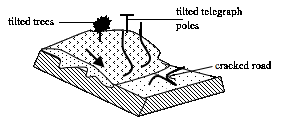
Soil
creep is activated by any process that loosens the soil, making it easy
to move gradually down the slope. The following factors influence soil
creep:
- Alternate heating and cooling of the soil particles.
- The freezing of water in the soil causing frost heaving.
- Removal of the soil further down the slope.
- Percolation of water into the soil, acting as a lubricant.
- Ploughing of the soil, a fact which makes the soil loose and more mobile.
Talus Creep
This
is also a very slow mass movement of screes. It is very common on sides
of mountains, scarps and valleys. It takes place due to the processes
of thawing and freezing and is more pronounced in high latitude regions.

Rock creep
Individual
rock blocks may move very slowly down a slope. It occurs commonly where
individual rock blocks are lying over clay materials. In the presence
of moisture, the clay surface becomes slightly slippery. The rock blocks
may creep slowly down the slope under the influence of gravity.
Solifluction
This
is the slow movement or flowing of weathered materials, especially when
mixed with water and gravels. It is limited on highlands and cold
regions.
Rapid mass wasting
This involves the movement of materials in form of mudflow,land slide, rock fall and earth flow.
Earth flow
This
type of movement occurs in humid regions. The materials on the earth’s
surface gets so saturated with water that it gains much weight, and
starts to move down the slope under the influence of gravity.This
normally occurs on the slopes of the hills or mountains. The removed
earth material leaves a shallow scar on its place of origin and it
creates terraces or mounds in its destination.
Mud flow
Mud
flow is the movement of a large mass of unconsolidated rocks down the
slope when saturated with water. It flows in semi liquid state. It is
common in desert slopes, which are not protected by a cover of
vegetation. This occurs, for instance, during a torrential storm when
more rain falls than the soil can absorb.
Land slide
This
is the rapid movement of surface rocks and soil down a steep slope such
as a cliff face. It includes slumping and sliding of materials. During
the movement, the block tilts and leaves holes. It is common in well
jointed limestone rocks, shale or clays. The common forms of landslides
are slump, debris slide,rock slide, rock fall, debris fall and
avalanche.
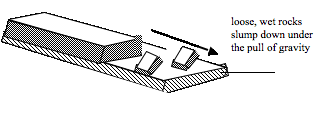
Rock fall
This
is the free-falling of a single mass of rock, common on steep slopes of
mountains and along scarp slopes of the sea. This is the most rapid of
all mass movements. If a rock fall occurs repeatedly, for a long time,
the broken rocks collect at the bottom of the slope in a mound called talus.
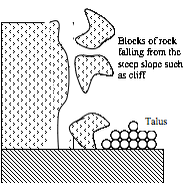
The Factors which Cause Mass Wasting
Describe the factors which cause mass wasting
Mass wasting is caused by a number of factors which include the following:
- Gradient or slope:When the gravitational force acting on a slope exceeds its resisting force, slope failure (mass wasting) occurs. Mass wasting is very common and severe in areas with steep lands as compared to flat or moderately flat lands.
- Weathering:Various processes of weathering weaken and loosen the rock, hence accelerating the process of mass wasting. For example, oxidation of metallic elements and hydration of the minerals in rocks create lines of fracture and, consequently, the onset of mass wasting.
- Amount of water present in the rocks:Water can increase or decrease the stability of a slope depending on the amount present. Small amounts of water can strengthen soils because the surface tension of water increases soil cohesion. This allows the soil to resist erosion better than if it were dry. If too much water is present the water acts as lubricating agent, reducing friction, and accelerating the erosion process, resulting in different types of mass wasting (i.e. mudflows, landslides, etc.). Water also increases the mass of the soil, this is important because an increase in mass means that there will be an increase in velocity and mass wasting is triggered. This is due to the fact that water lowers resistance of the soil material to gravitational forces and this facilitates movement.
- Vegetation:The roots of plants help bind the soil particles together making the soil resistant to agents of erosion and weathering. A compact soil cannot be eroded easily by running water, animals, wind or other agents of erosion. This makes the soil hard to break and hence resistant erode. Mass wasting processes, such as soil creep, cannot occur easily in soils well-covered with vegetation. Also the mass of vegetation cover blocks and prevents movement of the eroded material.Plants remove water from the ground via absorption. This reduces the amount of water in the soil and hence the bulkiness and weight of the soil. By so doing, they reduce the quantity of water in the soil. And because water lubricates the soil particles, enabling them to move, reducing this water means minimizing mass wasting.The sliding of bedding planes over each other is also reduced.
- The nature or type of the rock materials:Clay soil is compact and resistant to various types of soil erosion agents and mass wasting as compared to sandy soil, which is normally loose and easy to remove and transport by water, gravity, wind, etc. Thus, mass wasting may be more severe on sandy soil than its counterpart clay soil under similar prevailing conditions.
- Overloading:When the soil accumulates in one location as a heavy mass of the rock material, it can be moved either by action of gravitational force or application of just a little force. Landslides occur as a result of the soil accumulated on a sloping land to an extent of exceeding the resistant force of gravity. Movement occurs when the gravitational force exceeds the resistant force of soil material.
- Earthquakes:Earthquakes cause sections of the mountains and hills to break off and slide down. Earthquake tremors tend to loosen the soil material and make it easy to be removed and transported. It can accelerate rock falls, landslides and soil creeps.
- Human activities:The activities of man such as cultivation, burning, mining, transportation, animal grazing, etc, removes the soil cover or leads to shaking of the soil. These activities leads to loosening of the soil particles and hence making it ease to remove and carry away. Quarrying by undercutting the slope creates a vacuum underneath the soil. This accelerates the earth movement in the form of landslide, soil creep and mud flow, especially when accompanied by tremors cause by earthquake or heavy vehicles passing nearby.
- Climate:Climate has a great influence on mass wasting. Areas that receive heavy rains often experience mass movements, such as landslides and soil creep, more often compared to dry areas. On the other hand, a little amount of rainfall does not wet the soil and so cannot cause the soil to move.In cold regions, alternate freezing and thawing triggers mass wasting. When the water in the soil freezes it expands. This causes the soil to be lifted up. In the due course, the rock particles are split apart of broken down. This entire process causes movement of the soil material down the slope.
- Vulcanicity:Volcanic activity often causes huge mud flows when the icy cover of a volcano melts and mixes with the soil to form mud as the magma in the volcano stirs preceding an eruption.
The Effects of Mass Wasting to the Environment
Assess the effects of mass wasting to the environment
Mass
wasting has significant effects to the environment. The following are
some of the effects of mass wasting to the environment:
- Formation of scars and bare land:When a large mass of soil moves, such as it occurs in landslide, the process leaves behind a large portion of eroded, bare and unproductive land. This land is often not easily colonized by plants, a fact which stimulates further erosion on the bare scar. Scars are very common on slopes of mountains such as mounts Kilimanjaro, Kenya and Rwenzori.
- Soil erosion:When mass movement takes place, the load often removes almost all the vegetation on its way. This exposes the land to agents of erosion such as wind, animals, water, ice, waves, etc. Also the place from which the material has been removed forms a scar upon which water, ice and other agents of erosion can act and remove the soil, further leading to gullies, depressions and gorges.
- Formation of new landforms:The materials removed and transported to a distant location may form hills at their destination and form scars and depressions at the place of origin.
- Formation of lakes:Materials of landslide can block a river bed and valley, preventing downward movement of water. The blocked water accumulates on the upper side of a river valley to form a lake. Examples of such lakes include Lake Bujuku in the Rwenzori Mountains,Nyabihoho in Uganda and Funduzi in South Africa. Lake San Cristobal in Colorado, USA, was formed when mud flow dammed (blocked) a river in the San Juan Mountains.
- Diversion of a river course:The landslide material can block the natural river bed, forcing the river to divert and form a new route. This makes the river leave its usual flowing course, and form a new course. The direction of flow of the river is thus changed. This happened in the Rif Atlas Mountains of Morocco in 1963 when a mud flow pushed the course of River Rhesana 100 metres to the east.
- Formation of a fertile soil:If the removed material comes from a fertile land, it can form a fertile soil at the place of destination, where fertile soil never existed, and encourage agricultural activities to take place.
- Damage to property:Different categories of landslides may cause various damages to property and can adversely affect other resources. The effects of landslide are dangerous because they destroy everything in their path. Roads are blocked, hampering traffic flow. Homes, buildings and other infrastructures are destroyed. The water mains, sewers and power transmission lines are disrupted. Oil and gas production and transportation facilities are ruined.Farms are also destroyed by various forms of mass wasting.
- Loss of life:As human populations expand and occupy more and more of the land surface, mass movement processes become more likely to affect humans. The table below shows the impact of mass movement processes on human life over the last century.
| Year | Location | Type | Fatalities | |||
| 1916 | Italy, Austria | Landslide | 10,000 | |||
| 1920 | China | Earthquake triggered landslide | 200,000 | |||
| 1945 | Japan | Flood triggered landslide | 1,200 | |||
| 1949 | USSR | Earthquake triggered landslide | 12,000-20,000 | |||
| 1954 | Austria | Landslide | 200 | |||
| 1962 | Peru | Landslide | 4,000-5,000 | |||
| 1963 | Italy | Landslide | 2,000 | |||
| 1970 | Peru | Earthquake related debris avalanche | 70,000 | |||
| 1985 | Columbia | Mudflow related to volcanic eruption | 23,000 | |||
| 1987 | Ecuador | Earthquake related landslide | 1,000 | |||
| 1998 | Nicaragua | Debris avalanche and mudflow triggered by heavy rains during Hurricane Mitch | ~2,000 | |||
| 2001 | El Salvador | Earthquake-induced landslide | 585 | |||
| 2006 | Philippines | Rain triggered debris avalanche | >1100 | |||
| 2009 | Taiwan | Typhoon Marakottriggered landslide | 397 | |||
| 2010 | Gansu, China | Rain triggered mudflows | 1287 | |||
| 2013 | Northern India | Heavy rain triggered landslides | 5700 |
Weathering
Define the term weathering
Weathering
refers to a processes where by rocks disintegrate into small particles
due to the agents of weathering such as water, ice, wind, wave, etc. The
process results from the forces of weather, that is, changes in
temperature, frost action and rain action.
Types of Weathering
Identify types of weathering
The main forms of weathering include:
- Mechanical weathering
- Chemical weathering
- Biological weathering.
Mechanical weathering
This
is also referred to as physical weathering. It is a type of weathering
caused by changes in temperature. It is common in areas where there are
extreme changes in temperature such as hot deserts, arid and semi arid
regions.
Mechanical weathering include the following types:
Exfoliation
This
process occurs due to temperature change. During the day time rocks
expand due to high temperatures and contract during the night due to low
temperatures.Alternate heating and cooling set up powerful internal
stress in the top layer of the rocks.The stress produces fractures which
cause the outer layer to pull away leading to the cracking and
disintegration of rocks into small particles.
The
peeled off rock fragments fall to the bottom of the standing rocks and
are subjected to further alternate expansion and contraction and
disintegrate to even smaller fragments. The fragments collect at the
base of the standing rocks to form mounds of steeply sloping rock
fragments called talus or sometimes screes, but the
term is better used for angular rock particles produced by the action of
frost. The rocks that remain standing as exfoliation takes place are
called exfoliation domes. Exfoliation domes occur in desert,
semi-desert and monsoon regions. There are many exfoliation domes in the
Egyptian, Kalahari, Sahara and Sinai deserts.
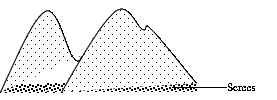
Frost action
This
is common in temperate regions where temperature falls up to freezing
point. When temperature falls (freezing point) water collects in the
rocks and it freezes, its volume increases causing the crack to deepen
and widen. Usually it involves the freezing of water in the cracks
during the night and thawing (melting) during the day in mountainous
areas.This action of thawing (melting) and freezing of water in the
cracks cause the rocks to shatter (break) into angular fragments which
form screes and talus. After thawing the cracks deepen further.
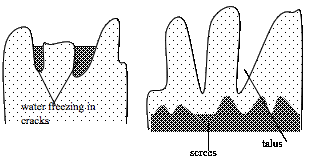
Alternate wetting and drying
This
usually occurs in tropical regions. These areas have seasonal rainfall
and they get rain during summer season and during winter season they are
dry. This causes the blocks to disintegrate.

Differences between Weathering Processes
Differentiate weathering processes
Chemical weathering
Chemical
weathering involves the decomposition of some of the minerals contained
in a rock. Some rocks decompose when they come into contact with water
(H2O), or oxygen (O2) and carbon dioxide (CO2), two of the gases that make up air.Chemical weathering includes the following processes:
- Oxidation– This happens when oxygen combines with a mineral. It takes place actively in rocks containing iron, when oxygen combines with iron to form iron oxides. This process is often preceded and accompanied by hydrolysis.The new minerals formed by oxidation are often easily attacked by other weathering processes.
- Carbonation– This process occurs when hydrogencarbonate ions react with a mineral to give a solublecompound whichcan be carried away in solution. Hydrolysis often accompanies carbonation.
- Solution–This refers to dissolution of a mineral with a chemical substance.Rain watercombines with both atmospheric carbon dioxide and oxygen to form weak carbonic acid. CO2(g) + H2O(l) → H2CO3(aq).So when the rain reaches the ground it consists of a weak acid called weak carbonic acid. This acid helps to dissolve many insoluble minerals into minerals soluble in water, and which can be carried away in solution. When rain containing weak carbonic acid falls in a limestone region, it reacts with limestone (calcium carbonate) and dissolves it into soluble calcium hydrogen carbonate, which can easily be carried away in solution.CaCO3(s) +H2CO3(aq) → Ca(HCO3)2(aq)In limestone regions, the rocks are dissolved and produce features like grike andclint(trough and ridge).
- Hydration– This is the process in which some minerals absorb water and swell up, causing internal stress and fracture of the rocks.
- Hydrolysis– This process involves the reaction of hydrogen (in the water) with certain mineral ions (in a mineral). This gives rise to the formation of different chemical compounds that can be easily weathered through other weathering processes.
NOTE:
Usually two or more chemical weathering processes take place at the
same time. Chemical weathering is most marked in hot wet regions.
Biological weathering:When
plants grow on rocks, their roots penetrate into rock joints which
later force the rocks to break apart. Also man contributes much to rock
disintegration through farming activities, mining, quarrying and
construction. Macro- and microorganisms also disintegrate rocks through
burrowing and by mineralization process. Bacteria, for example, in the
presence of air, break some minerals which are dissolved in the soil.
Plants also absorb minerals from the soil by their roots. Decayed
vegetation produce organic acid which remain in the soil. All of these
actions help to weaken the rocks.
The Significance of Weathering
Assess the significance of weathering
Weathering is important to man in the following ways:
- Weathering leads to soil formation. Soil is formed through the process of weathering of rocks. Various forms of weathering lead to rock disintegration and hence formation of the soil. The soil is an aggregate of organic and inorganic particles formed by different processes of weathering.
- Weathering may shape the rocks into attractive features which can attract tourists and hence earn the country and communities the much needed foreign exchange. An example of a feature that can attract tourists is the Bismarck Rock on the south shore of Lake Victoria.
- The processes of weathering weaken the rocks such that they can be easily acted upon by agents of erosion. The process helps to shape the earth and produce various landforms. This, in turn, influences the type of human activities that can take place in an area. So the process is very important in supporting life.
- When the rocks are weathered they become weak and hence easy to exploit, e.g. by quarrying. This process also helps to break up large rocks into small fragments such as sand, which is used for construction purposes.
- Weathering serves as carbon sink.Any process that reduces the amount of carbon dioxide from the atmosphere is termed as carbon sink. Some processes of weathering involve absorption of carbon dioxide from the atmosphere. This helps to remove excess carbon dioxide from the atmosphere. Limestone and other carbon-based sedimentary rocks are important carbon sinks.
The Concept of Erosion and Deposition
Define the concept of erosion and deposition
River
refers to a mass of water flowing through a definite channel over a
landscape from river source to river mouth. River source is the place
where a river starts. It may be in the melt water from glacier e.g.
river Rhome (France), a lake, e.g. Lake Victoria, the source of river
Nile, a spring e.g. Thames (England) or it can be formed following
steady rainfall e.g. river Congo. River mouth can be anywhere a river
pours its water, e.g. a lake, ocean or sea.
How Agents of Erosion and Deposition Operate on the Landscape
Examine how agents of erosion and deposition operate on the landscape
The river has three functions as it flows through its channel. These are river erosion, transportation and deposition.
River erosion
Erosion of a river operates in three ways, that is, head ward, vertical and lateral erosions.
- Headward erosion– this is the cutting back of the river at its source. It is through this erosion that a river increases its length.
- Vertical erosion– this is erosion by which a river deepens its channel.
- Lateral erosion– This is the wearing away of the sides of a river by water and its load. It is responsible for widening of a river valley.
River
erosion involves four related processes. These are abrasion
(corrasion), attrition, corrosion (solution) and hydraulic action.
- Hydraulic action:This is the process whereby the force of moving water plucks and sweeps away loose materials, such as silt, gravel and pebbles. Materials plucked by hydraulic action are responsible for bank caving and slumping.
- Corrasion (abrasion):This is when the load of the river rubs against the bed and sides of the river channel. This causes wearing away of the sides and bed of the river. The amount of load determines the nature of erosive power and rate of erosion. This is a source of pot holes in the river bed.
- Attrition:This is when the rock fragments in a river’s load are broken into small fragments due to collision against one another as the load is carried downstream along the river channel. As the river moves along its course, its fragments get progressively smaller because of disintegration and wearing away.
- Corrosion (solution):River water dissolves certain minerals leading to dissolution and disappearance of some rocks, e.g. limestone, rock salt and chalk.
River transport
This
is the process which involves carrying away of the weathered and
eroded, loose materials from one place to another. The materials carried
out by river is called load. River transports its load in four ways.
These ways are as follows:
- Saltation– this is the process in which small pieces of the rock fragments are carried by a river while bouncing on the river bed.
- Traction– this is the dragging or rolling of large boulder such as pebbles along itsriver bed.
- Suspension– This involves transport of fine or light materials like silt and mud, which are carried in suspension forms. This is common when the river flow is too strong.
- Solution– this involves moving some materials that dissolve in water, which are carried away in solution form.
A
river transports its load until it has insufficient energy to transport
it any further. When this happens, the load is deposited.
River deposition
A river deposits its load when its volume and speed decrease. A river volume decreases when:
- It enters an arid region especially a hot desert;
- It crosses a region composed of a porous rocks e.g. sand and limestone; and
- During the dry seasons or in a period of drought.
A river speed decreases when:
- It enters a lake or sea; or
- When it enters flat or gently slopping plain such as a valley bottom.
Deposition
takes place when the river has insufficient energy to carry its entire
load. The first part of the load that is dropped consists of boulders
and pebbles. The last part to be dropped is the fine sediment, called silt. Deposition takes place at any point in a river’s course.
THE LONG PROFILE OF A RIVER
The
long profile of a river is the line following the course of a river
from its source to its mouth. Three courses or sections of a river can
be distinguished. These are:
- The upper course.
- The middle course.
- The lower course.
The upper course/section
This is the first stage of a river. It is sometimes called the youth or torrent course.Its characteristics are as follows:
- It is the river source.
- The speed of a river is high.
- Most of the works of the river include vertical erosion.
- The cross-section of a river valley in this section of a river is V–shaped.
- The slope of a profile is very steep.
- It is sometimes utilized for hydroelectric power (H.E.P) generation.
Erosional and Depositional Features for each Agent
Examine erosional and Depositional Features for each Agent
The
main features of the upper section are deep and narrow, V-shaped
valley; a steep gradient; pot holes on the river bed; interlocking spurs
and waterfalls and rapids, often with plunge pools.
- V–shaped valley: this is a deep, narrow valley at youth/first stage of a river.
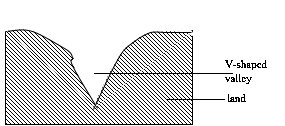
- Pot holes:These are circular depressions on the river bed. They are formed when pebbles carried by the swirling water cut circular depressions in the river’s bed.
- Interlocking spurs:An interlocking spur, also known as an overlapping spur, is one of any of a number of projecting ridges that extend alternately from the opposite sides of the wall of a young,V-shaped valley down which a river with a winding course flows. Each of these spurs extends laterally into a concave bend of the river such that when viewed either upstream or from overhead, the projecting ridges, which are called spurs, appear to "interlock" or "overlap" in a staggered formation like the teeth of a zipper.As the river erodes the landscape in the upper course, it winds and bends to avoid areas of hard rock. This creates interlocking spurs.

- Waterfalls and rapids-Waterfall:A waterfall is a place where water flows over a vertical drop in the course of a stream or river. A waterfall is formed when there is sudden change or drop in the bed of a river. Although waterfalls can occur in almost any part of a river’s course, they are most common in the upper course. Examples of waterfalls are Owen Falls in Uganda, Victoria Falls in Zimbabwe and The Livingstone
The Yosemite Falls in USA
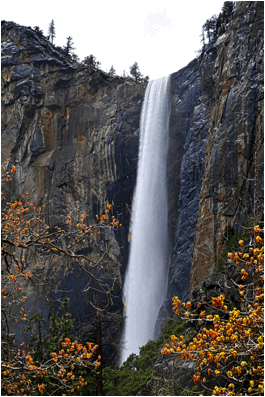
- Rapids:These are sections of a river where the river bed has a relatively steep gradient, causing an increase in water velocity and turbulence.Rapids are characterised by the river becoming shallower with some rocks exposed above the flow surface. As flowing water splashes over and around the rocks, air bubbles become mixed in with it and portions of the surface acquire a white colour, forming what is called "whitewater".Rapids occur where the bed material is highly resistant to the erosive power of the stream in comparison with the bed downstream. Very young streams flowing across solid rock may be rapids for much of their length.
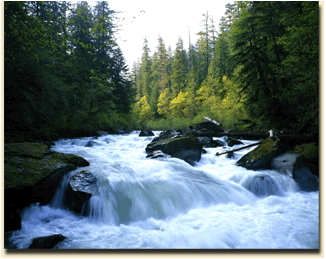
- Plunge pool:This is a large depression formed at the base of a waterfall.
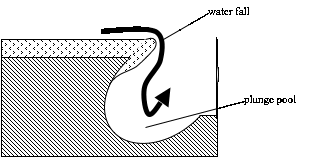
- Gorge:It is a steep, narrow and elongated valley. A gorge often is formed when a waterfall retreats upstream, e.g. a gorge found in Victoria Falls.
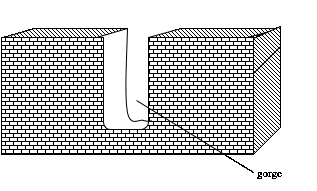
The middle/maturity stage/section
This is the second stage of a river. The main features of this section are bluffs and waterfalls and rapids.
The characteristics features of the middle course of a river valley
- The speed of a river is fairly low.
- Most of the work of a river is transportation.
- The cross–section of a valley in this section is an open V.
- The slope of a relief is gentle
- The volume of a river increases.
- Lateral erosion predominates.
Features associated with the middle course of a river valley
- Bluffs:These are steep slopes of the truncated spurs in middle course where interlocking spurs turn into bluffs.
- Waterfalls and rapids:Waterfalls and rapids can also be found in the middle stage of the river valley. This is mainly caused by river rejuvenation which increases erosive activity and transportation, hence development of waterfalls.
The old/lower stag
Third
is the third stage of a river. The main features of the lower section
of a river valley are a flood plain; braided river; ox-bow lake; levee
and deferred tributary and delta.
Its characteristics are as follows:
- It is the river mouth.
- Always there are gradient falls or slope falls.
- The main work of a river is deposition.
- The cross–section of a valley is a U–shaped valley.
- The speed of a river is decreased.
- The river valley is very wide.
The Importance of Erosional and Depositional Features to Human Beings
Assess the importance of erosional and depositional features to human beings
Some
features resulting from erosion and deposition are very important to
human beings in the following ways: Loess form very fertile soil in
desert land, water falls attract tourists, headlands in coastal areas
are natural ports. Coastal features form breeding places for fish, coral
reefs are used as building materials and for settlement.
Artificial Forces
The Causes and Effects of Artificial Forces
Describe causes and effects of artificial forces
Apart
from the effects caused by natural forces that affect the earth,
man-made (artificial) forces have an effect of creating artificial
landforms and features on the earth’s surface. These include the
following features:
- Man-made lakes such as Lake Cabora Bassa in Mozambique, Lake Volta in Ghana, Lake Karibain Zambia (the world's largest artificial lake and reservoir by volume) and Lake Nasser in Egypt.
- Man-made rivers in the form of canals such as Suez and Panama Canals.
- Wells and boreholes
- Roads, harbours, railways, airports, bridges, etc.



No comments